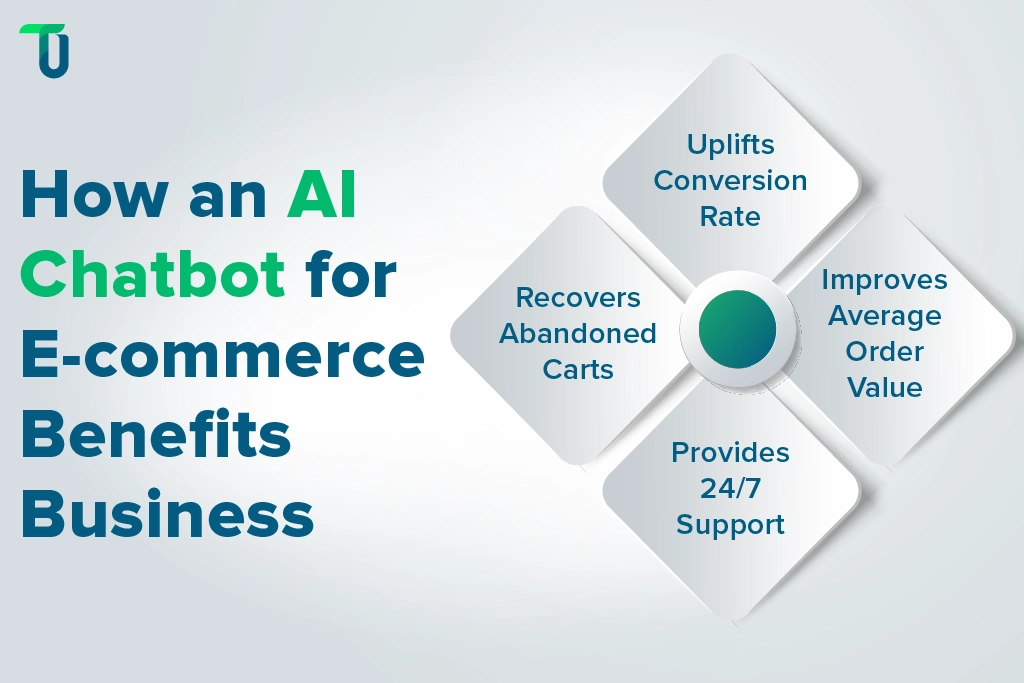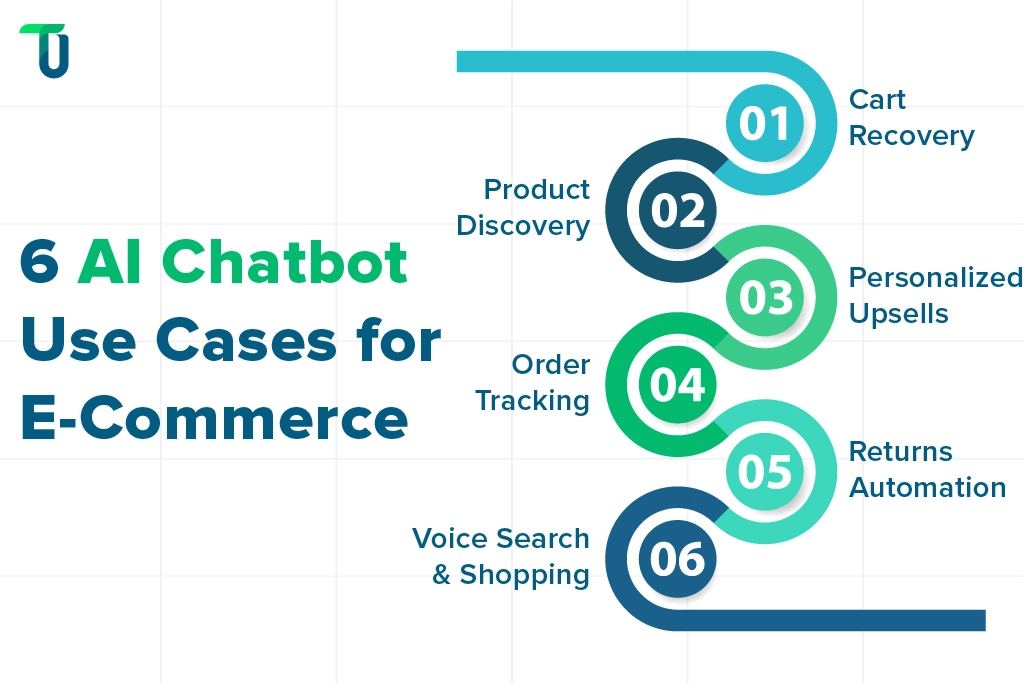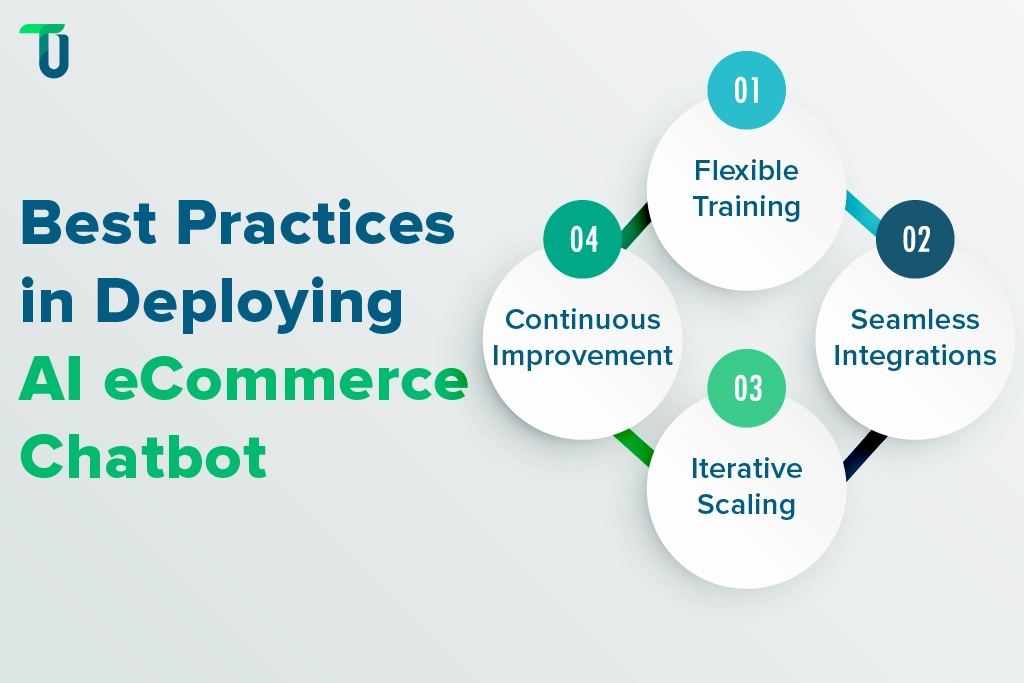Not Your Average Bot: What Makes an AI Chatbot ‘Custom’ for E-Commerce
Let’s be honest—most bots are forgettable. They spit out templated replies, struggle with anything beyond “Where’s my order?”, and leave your customers more frustrated than supported.
But a custom AI chatbot for eCommerce? That’s a different breed.
It’s not just a tool—it’s an extension of your brand’s brain. Built using domain-trained Natural Language Processing (NLP), it speaks your customer’s language and understands your business logic. That means it doesn't confuse "blue running shoes size 9" with "blue suede boots for toddlers"—because it’s been trained on your product catalog, your SKUs, and your customer queries.
It’s also deeply integrated with your backend systems—ERP, CRM, CMS, and payment gateways. So when a customer asks, “Is this available in-store?” or “Can I apply my loyalty points?”, the chatbot doesn’t fumble. It pulls real-time data and responds with accuracy. It’s like giving your website the power of a fully-trained, always-on sales rep who knows your inventory, policies, and promotions cold. That’s the real power of an AI chatbot for customer service.
Take Sephora for example. Their AI eCommerce chatbot, integrated with Kik and Facebook Messenger, offers personalized product recommendations based on past purchases and preferences. When users interact, the bot doesn’t just push random makeup—it offers curated options, complete with tutorials, store availability, and check-out support. The result? A 11% increase in conversion rates for users who used the bot versus those who didn’t.
Now add intent recognition into the mix. A smart chatbot doesn’t just parse words—it decodes intent. If someone says, “I need this by Friday,” it knows urgency. If they say, “Is this cruelty-free?” it recognizes a values-based concern and tailors the pitch accordingly.
That’s what separates a chatbot that talks from one that converts. A generic bot is a cost center. A custom AI chatbot for eCommerce, designed as an AI shopping assistant and built with conversational AI marketing in mind? It's a revenue stream.
Your Store Doesn’t Sleep—Neither Should Your Support
AI chatbots deliver instant, personalized experiences at scale. No burnout. No wait times. Just revenue-driving conversations, 24/7.
Real Impact, Real Fast: Business Benefits That Matter to the C-Suite
Let’s skip the fluff. C-suite leaders don’t invest in tech because it’s trendy. They back what moves the needle. And when it comes to AI-powered chatbots in e-commerce, the results aren’t just impressive. They’re immediate.

1. Conversion Rate Uplift
Every click matters. But it’s what happens after the click that defines your bottom line. A custom AI chatbot for eCommerce doesn’t just chat. It converts. By engaging high-intent users in real time, resolving their objections, and guiding them down the funnel with contextual nudges, these bots shorten the decision-making cycle and reduce drop-offs.
Whether it’s a lead generation chatbot for eCommerce or an AI chatbot for sales conversion or an AI shopping assistant, the impact is measurable. Instead of forcing users to hunt through your site or wait for a human agent, the bot brings answers and recommendations directly to them. Whether it's product comparisons, size suggestions, or payment support, fewer blockers mean faster conversions. And when you multiply that across thousands of sessions? You’re looking at a direct lift in revenue, not just engagement.
2. AOV (Average Order Value) Improvements
An AI shopping assistant isn’t just reactive. It’s predictive. It reads user behavior, understands purchasing patterns, and leverages that data to increase basket size. Think upsells, cross-sells, and bundles—all served in a natural, conversational flow that feels helpful, not pushy.
Because it knows what complementary items are often bought together, it can suggest the right product at the right moment, turning a single-item checkout into a full-cart experience. Unlike a static “You may also like” section, the best AI chatbot for eCommerce personalizes every interaction in real-time, increasing AOV with minimal friction. It’s a perfect blend of conversational AI marketing and smart product discovery.
3. 24/7 Support, Without the Overhead
Traditional support models are linear. More queries mean more agents, more shifts, more cost. An AI chatbot for eCommerce breaks that equation.
It handles thousands of queries simultaneously, at any hour, across geographies, without downtime or burnout. From product questions to return policies, or even acting as an AI chatbot for order tracking or AI chatbot for customer service, the bot resolves up to 80% of Tier 1 issues autonomously. That means fewer tickets, faster resolution, and significant savings on staffing and operational costs.
And when escalation is needed, the bot captures full context, making hand-offs to live agents faster and smoother. You’re not just saving support hours. You’re optimizing the entire support experience while keeping AI chatbot pricing aligned with long-term ROI. It supports at scale, powered by conversational AI marketing principles.
4. Cart Abandonment Recovery
Most shoppers don’t need more ads. They need fewer reasons to leave. An AI chatbot to reduce cart abandonment tackles the problem right at the source.
By triggering intelligent reminders, offering limited-time discounts, or addressing last-minute hesitations (like shipping time or return policy), the AI shopping assistant re-engages users before they exit. And because it’s powered by real-time behavior tracking, it knows when and how to intervene without being intrusive.
It’s not about chasing carts with emails after the fact. It’s about preventing them from being abandoned in the first place. That’s proactive revenue recovery, built into your digital storefront with the help of an intelligent AI chatbot for eCommerce.
Also Read: How our custom-built AI Chatbot benefited a recruitment giant by automating candidate search
From Browsing to Buying: 6 High-Impact Use Cases You Can Deploy Today
An AI chatbot for eCommerce isn’t just a support tool—it’s your most versatile digital teammate. The kind that never sleeps, never drops context, and always moves the customer closer to checkout. Whether you're implementing conversational AI marketing or streamlining customer journeys, this is the tech that delivers. If you're wondering where to plug it in for immediate ROI, start with these six high-impact use cases.

1. Cart Recovery
Let’s face it—abandoned carts are losing revenue. But they don’t have to be.
With AI-powered cart recovery, your AI chatbot to reduce cart abandonment detects when a shopper is about to leave and intervenes with a smart, contextual prompt. It might offer a reminder, clarify shipping timelines, or serve up a limited-time discount—all in real time. No delay. No follow-up emails. Just intelligent, instant nudges that reclaim revenue before it slips away.
An ecommerce chatbot tailored for cart abandonment recovery ensures that fewer shoppers slip through the cracks.
2. Product Discovery
Too many choices can stall a purchase. A custom AI chatbot for eCommerce simplifies that journey.
By asking a few quick questions or analyzing browsing behavior, it filters through your entire catalog and recommends products that match the customer’s intent, whether that’s “something under ₹2,000,” “gift for a 10-year-old,” or “vegan leather bag.” It’s like having a personal AI shopping assistant built into your site, guiding users to what they actually want without the overwhelm.
3. Personalized Upsells
Forget static “you may also like” carousels. A smart ecommerce chatbot knows what the customer needs before they do.
It suggests complementary products based on current cart items, past purchases, or even regional buying trends. Selling sneakers? The bot can recommend performance socks. Buying a laptop? It might offer a matching sleeve or warranty plan. These AI chatbot for sales conversion tactics aren’t generic—they’re timely, relevant, and designed to lift AOV without lifting a finger.
4. Order Tracking
This is the number one reason customers flood your support team. But it shouldn’t be.
With a backend-integrated AI chatbot for order tracking, order tracking becomes self-serve. A quick message like “Where’s my order?” triggers real-time updates—no login, no waiting. It’s fast, frictionless, and offloads your agents from repetitive queries, while giving customers the instant clarity they expect.
This use case alone makes an AI shopping assistant indispensable for modern online stores.
5. Returns Automation
Returns are inevitable. But they don’t have to be painful.
A well-trained AI chatbot for eCommerce can initiate return requests, check eligibility, share shipping instructions, and even process refunds—without human intervention. It walks customers through each step, ensures policy compliance, and keeps them informed throughout. The result? A smoother post-purchase experience and a stronger chance they’ll come back, not churn.
Many retailers now combine AI chatbot for order tracking and return handling to deliver seamless support.
6. Voice Search and Shopping
Your customers are already talking to Siri and Alexa. Why not your store?
AI chatbots for eCommerce with voice capabilities offer a hands-free, fast-track shopping experience. Whether it's “Find red dresses under ₹5,000” or “Track my recent order,” voice search blends convenience with speed. It’s especially powerful on mobile, where typing is tedious but tapping a mic isn’t.
The next generation AI chatbot to reduce cart abandonment will speak your customer’s language—literally.
Case in Point: Brands Using AI Chatbots to Crush It in E-Commerce
Smart brands aren’t just experimenting with AI chatbots—they’re engineering outcomes. Here are two that turned conversation into conversion:
Sephora: Enhancing Beauty Consultations with AI
Sephora, a global beauty retailer, integrated AI chatbots to elevate its digital customer interactions. The Sephora Reservation Assistant, launched on Facebook Messenger, streamlined the appointment booking process for in-store makeovers. This initiative resulted in an 11% increase in booking rates compared to other channels, simplifying the customer journey and increasing in-store traffic.
Additionally, Sephora's Virtual Artist chatbot allowed users to try on makeup products virtually, providing personalized recommendations and enhancing the online shopping experience. This innovative approach not only increased customer engagement but also contributed to higher conversion rates.
H&M: Personalizing Fashion with AI Chatbots
H&M, a leading fashion retailer, implemented an AI-powered chatbot on the Kik messaging platform to offer personalized styling advice. The chatbot engaged users through style quizzes and provided outfit recommendations based on individual preferences. This interactive experience resulted in a 70% user engagement rate, accompanied by a notable increase in time spent on the H&M app and a boost in online sales for recommended items.
By leveraging AI chatbots, H&M successfully enhanced customer engagement, streamlined the shopping experience, and drove sales growth.
Avoid the Pitfalls: Best Practices for Successful AI Chatbot Deployment
A powerful AI chatbot for eCommerce can transform your CX and revenue metrics—but only if it's deployed right. Too often, brands rush to go live and end up with a half-baked bot that confuses more than it converts. Avoid the common missteps and build it to scale from day one with these non-negotiable best practices.

1. Don’t Over-Script—Train for Flexibility
Your customers don’t speak in templates, so your chatbot shouldn’t either. Over-scripting leads to robotic replies and dead-end loops. Instead, invest in training your chatbot using real customer queries, FAQs, and support transcripts. Let NLP models learn how users actually talk—typos, slang, urgency, and all.
This isn’t about pre-defining every conversation. It’s about building a bot that can handle natural, unscripted language while still steering users to outcomes that matter.
2. Avoid Isolated Deployment
Deploying your chatbot in a silo is like putting a star salesperson in a room with no access to inventory or CRM. Integration is key.
Your AI chatbot for e-commerce should integrate with your backend systems—orders, shipping, loyalty, and product catalog—so it can provide smart, contextual answers in real-time. Whether it’s checking stock availability or applying discount codes, disconnected bots slow the experience and kill trust.
3. Start Narrow, Then Scale
You don’t need your chatbot to do everything on day one. Start with high-impact use cases, such as cart recovery, order tracking, or returns, and roll them out gradually. Measure performance, iterate fast, and let the data guide your roadmap.
Scaling with intention ensures better outcomes and gives your team time to optimize both technology and tone before expanding functionality.
4. Design for Escalation, Not Isolation
Even the smartest bots hit their limits. And when they do, escalation should feel seamless, not like a frustrating handoff.
Ensure your chatbot can recognize complex queries and route them to a human agent, with full conversation context attached. That context-sharing avoids repetition, speeds up resolution, and protects the customer experience from falling apart when automation encounters a limitation.
5. Keep Training—It’s Not “Set and Forget”
Customer behavior evolves. So should your bot.
Schedule regular training cycles using fresh data—new queries, seasonal trends, and customer feedback. Monitor what the chatbot is missing or misinterpreting, and continually refine its NLP models. This isn’t a one-time launch. It’s an ongoing optimization loop that keeps your AI chatbot for eCommerce sharp, relevant, and revenue-aligned.
Final Word: AI Chatbots Aren’t the Future of E-Commerce — They’re the Present
E-commerce isn’t slowing down—but the brands that hesitate will. The most forward-thinking retailers aren’t waiting for a perfect AI moment. They’re already seeing results—faster checkouts, higher AOVs, and always-on AI chatbot for customer service without the overhead. Every day you delay is a day your competitors get smarter, leaner, and closer to your customers.
Deploying an AI chatbot for eCommerce isn’t about following a trend—it’s about owning your growth strategy. Done right, it becomes the eCommerce chatbot engine that powers conversions, scales service, and personalizes every interaction at speed. With tools like AI shopping assistants and conversational AI marketing tactics built in, your brand can deliver smarter shopping journeys that feel effortless and personal.
This isn’t a test run. It’s your competitive edge. And the time to act is now.
Ready to Build Your Custom AI Chatbot for E-Commerce?
If you're serious about scaling revenue, reducing operational load, and delivering hyper-personalized customer experiences, it's time to move from exploration to execution.
At Tenup Software Services, we don’t do one-size-fits-all bots. We build domain-trained, backend-integrated AI chatbots tailored for your eCommerce business—whether it's a chatbot for customer service, sales conversion, or AI shopping assistant role—designed to drive real outcomes from day one.
- Boost conversion rates
- Improve AOV with intelligent upsells
- Automate 24/7 support at scale
- Recover lost carts in real time
Let’s turn your storefront into a growth engine.
Power Your E-Commerce with Smarter Conversations
Give customers instant support, personalized product recommendations, and seamless shopping experiences—all powered by AI.
Frequently asked questions
Are AI Chatbots Useful for E-Commerce Support and Sales?
Yes, AI chatbots can handle routine support and sales queries effectively, saving time and reducing workload. However, their success depends on good training data, clear escalation rules, and smart usage limits. They're best used to assist—not replace—human agents.
What is an AI chatbot for e-commerce, and how does it work?
An AI chatbot for e-commerce is a virtual assistant that uses NLP and machine learning to chat with customers, recommend products, answer questions, and automate support. It works 24/7, personalizes the shopping experience, and integrates with your backend systems to boost sales and reduce manual workload.
What are the benefits of using conversational AI in marketing for e-commerce?
Conversational AI boosts e-commerce marketing by delivering real-time, personalized support, guiding buyers through the funnel, increasing conversion rates, recovering carts, and improving retention—all while reducing costs and freeing up human teams.
Is it possible to integrate an AI chatbot with my existing e-commerce platform?
Yes—AI chatbots easily integrate with platforms like Shopify, WooCommerce, and Magento. With just a plugin or code snippet, they connect to your catalog, automate support, and personalize shopping—boosting conversions without heavy dev work.
How do AI chatbots personalize the shopping experience for customers?
AI chatbots use real-time data—like browsing history, purchase behavior, and preferences—to deliver tailored product suggestions, offers, and support. This creates a more engaging, relevant experience that boosts satisfaction and repeat purchases.
What is the cost of implementing an AI chatbot for my e-commerce business?
AI chatbot costs can range from free or low-cost for basic tools, to $10,000 and up for custom, fully integrated solutions. Upper-end pricing depends on features, platform, and complexity—making chatbots scalable for businesses of all sizes.

